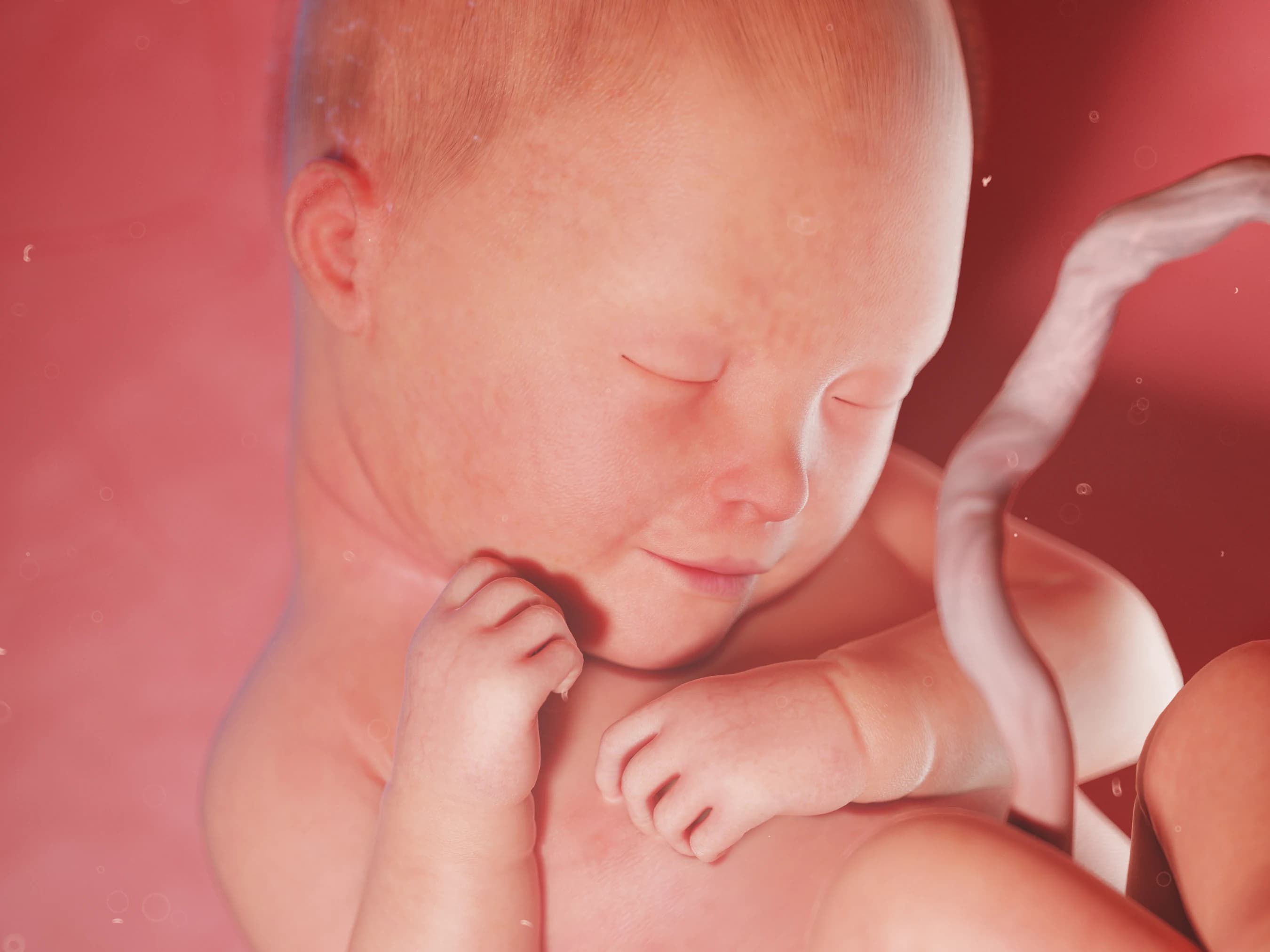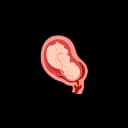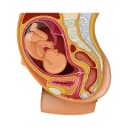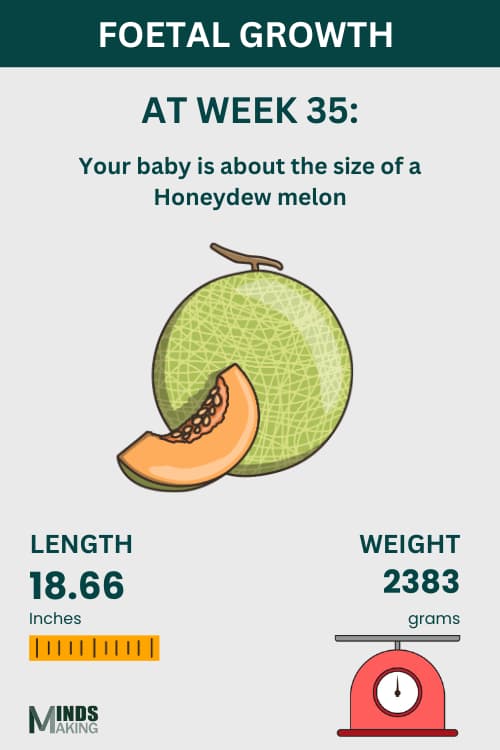Your Pregnancy at Week 35
sciencephoto

Written by Mindsmaking Medical Writer
Fact Checked by Mindsmaking Professionals
17th, November, 2025
At week 35 of pregnancy, you're on the home stretch, with just a few weeks left until you meet your little one! By now, you might notice more intense Braxton-Hicks contractions as your body gears up for labour.
At week 35, You're well into your 8th month of pregnancy, and it must feel like the finish line is approaching! While you might still have 5 or more weeks left, there's a chance you could be meeting your baby in just 3 weeks. Remember that babies don't usually arrive right on their due date. Your little one will make their grand entrance when they're ready.
Key Takeaways
This week, your baby is gaining weight quickly, with fat accumulating in its limbs. From now on, it will gain about half a pound per week.
Your baby measures around 18.66 inches and weighs about 2383 grams, comparable to a honeydew melon.
Yellow stains on your bra are likely colostrum, an early milk rich in antibodies that help protect your baby from infections. Some women start producing colostrum weeks or even months before birth.
At 35 weeks pregnant, your uterus has grown from about 500 to 1,000 times its original size.
Pregnancy hormones can cause your gums to swell, become tender, and bleed. Continue regular brushing and flossing, and ensure you get enough vitamin C.
As you near your delivery date, it's normal for your baby's movements to decrease due to limited uterine space. However, you should still feel at least 10 movements per hour. Suppose you don't contact your doctor.
To manage frequent nighttime urination, limit fluid intake for an hour or two before sleep. This can help improve sleep quality by reducing bathroom trips.
If you want to be involved in the birth, discuss your preferences with your partner and their healthcare provider to ensure you're prepared and everything goes smoothly on the day.
Reviewing postpartum care and recovery information will help you prepare and understand what to expect.
Take a peek

Bodybuilding
This week, your baby gains weight quickly as fat accumulates in their limbs, making them plumper.

Snuggling
Your baby's movements have changed from somersaults and flips to wiggles or as there is less space in your uterus.

Ready for debut
This week, almost all babies face down towards the cervix, ready for exit.
Baby Development at Week 35
This week is for rapid weight gain as fat accumulates in your baby's limbs. From now on, your baby will gain approximately half a pound each week. If you were to give birth this week, your baby would be considered premature and would require specialised care. Babies born at 35 weeks may face digestive issues, breathing difficulties, and a longer hospital stay. However, the likelihood of long-term survival is still very high(3).
At this stage, your baby has less space in the womb, which might mean fewer somersaults or flips, but they will continue to kick frequently. It's important to monitor their movements closely; a noticeable decrease or complete lack of movement could indicate a serious issue, such as distress, and should not be ignored. While the nervous and immune systems are still maturing, other aspects of your baby's development, including their hair and toenails, are fully formed. Additionally, their kidneys are functioning properly, and their liver has started processing waste products.
Your baby is probably in the head-down position this week, preparing for an exit. You may experience sore ribs as they may be kicking upward. The good thing is that your baby's head-down puts less pressure on your diaphragm and can make breathing easier.
Mindsmaking

Body Changes at Week 35
At this stage, you're likely feeling very tired. Your cervix may start to dilate, which could cause sharp pain in your vagina, but this isn't necessarily a sign of labour, just your body preparing. You might also experience painless Braxton Hicks contractions, which are practice contractions and don't indicate that labour is imminent. Contact your physician if these contractions become regular, intensify, or come closer together.
You might notice swelling in your ankles, fingers, and face. If this swelling is sudden or severe, it could be a sign of preeclampsia, a condition marked by high blood pressure that requires medical attention. Other common issues at this stage include haemorrhoids, tender breasts, constipation, heartburn, and indigestion. Your ribs might feel sore with the baby facing down and kicking. The baby might have dropped lower into your pelvis, which can relieve pressure on your diaphragm and ribs but increase pressure on your bladder, leading to more frequent bathroom trips.
If you notice yellow stains on your bra, it's likely colostrum, an early form of milk rich in antibodies. Some women start producing it weeks or even months before giving birth. Colostrum helps protect your baby from stomach bugs and infections. About 3 to 5 days after birth, your regular milk will come in, and your breasts will become fuller.
Read This Next
No posts available
Baby Bump At Week 35
At 35 weeks pregnant, your uterus has expanded to roughly 500 to 1,000 times its original size. While this number might seem extreme to others, it likely feels even more significant to you, given the physical changes and discomfort you're experiencing.
The distance from your belly button to the top of your uterus is approximately 6 inches. You've likely gained between 25 and 30 pounds, and there may or may not be additional weight gain for the remainder of your pregnancy.
Pregnancy Symptoms at Week 35

Braxton hicks contractions
You might notice more Braxton Hicks contractions now. These are "practice" contractions where your uterus tightens for up to two minutes and may or may not cause discomfort. Unlike true labour contractions, which are regular, intensify over time, and become more frequent, Braxton-Hicks contractions are irregular, unpredictable, and do not increase in intensity. Factors like dehydration, sexual activity, increased physical activity, or a full bladder can trigger them. Drinking water or changing your position can help alleviate them. Use these contractions as an opportunity to prepare for childbirth by practising labour breathing exercises.

Bleeding gums
Pregnancy hormones cause your gums to swell, become tender, and bleed. It is important to maintain regular brushing and flossing, even if you notice blood, a common issue during pregnancy. To help strengthen your gums, ensure you're getting enough vitamin C; a glass of orange juice can be a good source. However, if the bleeding continues, visit your dentist to prevent potential issues like gingivitis or tooth decay.

Nesting
In the final weeks of the third trimester, many women experience a strong urge to "nest," though not everyone does. This nesting instinct usually involves a strong desire to clean and organise your home in preparation for the baby's arrival. If you feel this way, letting others handle heavy lifting and strenuous tasks is important to avoid overexerting yourself.

Clumsiness
At 35 weeks pregnant, it's normal to feel clumsier than usual, and you can attribute this to your pregnancy. As your belly grows, shifting your centre of gravity can make you more prone to tripping, bumping into things, or spilling drinks. Additionally, hormonal changes are causing your ligaments to be more relaxed and your joints to be looser, affecting your balance and coordination. All these factors together contribute to a greater likelihood of feeling unsteady.

Linea nigra
During pregnancy, you might notice a vertical line down the centre of your belly called the linea nigra. This line can be more noticeable if you have darker hair or skin. It appears due to hormonal changes, particularly increased progesterone and oestrogen, which affect melanocytes, cells that produce skin pigment. The linea nigra is just one of the many skin changes that can occur during pregnancy.
Pregnancy Concerns at Week 35
As you approach your delivery date, you might notice a decrease in your baby's movements, which is normal due to the limited uterine space. However, you should still feel your baby move at least 10 times an hour. Suppose you don't contact your doctor right away. While it's likely that everything is fine, it's important to be checked.
Additionally, reach out to your doctor if you experience:
- Bleeding
- Regular, painful contractions in your abdomen or back
- Increased vaginal discharge with an unpleasant odour
- Your water breaking
- Fever or chills
- Changes in vision or blind spots
- Painful urination
- Severe headaches
Health Tips for Pregnancy Week 35
Eat zinc-rich foods
Zinc is crucial in supporting healthy growth and development during pregnancy. Pregnant women need a slightly higher amount of zinc compared to non-pregnant women. It's relatively easy to meet your zinc needs if you eat meat, fish, or seafood, as these are the richest sources of zinc. For those who are vegetarian, zinc can also be found in beans, nuts, and whole grains, though these are not as high in zinc as animal products. You can also consider taking a zinc supplement as it helps to slightly reduce preterm births, but make sure to consult your healthcare provider before starting any supplements.
Exercise safely
As you approach the end of your pregnancy, it's important to stay active, but you may need to adjust your exercise routine for safety. Begin with gentle activities and gradually increase intensity based on how you feel. Always listen to your body and avoid exercise if you experience pain, overheating, or breathlessness. Avoid activities that could cause a fall or impact your abdomen, such as contact sports or skiing. Wear loose clothing to prevent overheating and stay hydrated.
Reduce your water intake before bedtime
As you approach the later stages of pregnancy, the increasing size of your uterus puts more pressure on your bladder, leading to frequent urination. Drinking much water just before bed can exacerbate this issue, causing you to wake up multiple times to use the bathroom at night. To help manage this, try reducing your fluid intake an hour or two before sleep. This can help minimise nighttime disruptions and improve your overall sleep quality.
Try perineal massage
Perineal massage might be beneficial in preparing your vagina and perineum (the area between the genitals and anus) for childbirth. This practice helps stretch these areas and potentially reduce the risk of tearing during a vaginal birth. Tearing during childbirth is quite common, occurring in 53% to 79% of women who deliver vaginally. It's generally safe and can be done by you or your partner using thumbs or forefingers to press downward and sweep side to side. For best results, massage three to four times a week for at least five minutes each session,
Take time to relax
Having a newborn will transform your life in many ways, requiring you to adapt and make changes to ensure your baby's comfort and well-being. Before this new chapter begins, take some time to pamper yourself. Enjoy relaxing activities, spend quality time with your partner, and indulge in what makes you happy, even if it's just catching up on sleep. Embrace the simplicity of life during this time and remember to practice gratitude. Soon, your baby will be joining a loving and dedicated mother.
Advice for Partners
Has your partner packed their hospital bag yet? If not, you can assist them in collecting everything needed for the big day. You might create a list together or use our Hospital Bag Checklist. Also, remember to pack some essentials for yourself, as you may not know how long labour and delivery will take.
If you also want to be involved in your baby's birth, talk about it with both your partner and their healthcare provider. Discuss options like whether you'll be allowed to cut the umbilical cord or film the birth. It's important to clarify these details in advance so you can make any necessary preparations and ensure everything goes smoothly on the day.
Pregnancy Checklist for Week 35
- Try packing your bags for labour and for after the birth. Even if you're planning a home birth, it's wise to keep everything you need in one place for convenience.
- Discuss pain relief options with your midwife. Even if you're aiming for a drug-free birth, it's helpful to be aware of your choices in case you decide to use them later.
- Read more about postpartum care and recovery to understand how to prepare and what to expect.
- If you attended a childbirth class, go over your notes and practise the breathing techniques you learned.
- Unbox and set up any baby gear you have, and wash and sanitise all items your baby will use or come into contact with to ensure they are clean and safe.
Frequently Asked Questions
How big is my baby at week 35?
Your baby weighs about 2383 and continues a steady weight gain. It is now 18.66 inches long and will likely not acquire any more height until delivery. This week, your baby can be compared to the size of a honeydew melon.
What is my baby doing in the womb at 35 weeks?
At 35 weeks of pregnancy, most babies gain weight, causing their limbs to look plumper. Many babies also start to move into a head-down position in preparation for birth around this time. This position can pressure the pelvis and cause lower back aches or discomfort as your body adjusts to the baby's new position.
How many months is 35 weeks pregnant?
At 35 weeks pregnant, you're roughly halfway through your eighth month. Your belly might seem ready to burst because your baby is nearly prepared for their arrival. Although it's getting a bit tight in there, you'll still feel your baby moving, and these movements will continue through week 36 and right up until delivery.
Is it normal to be tired at 35 weeks pregnant?
Feeling tired at 35 weeks pregnant is quite normal. As you near the end of your pregnancy, your body is working hard to support you and your baby, which can lead to increased fatigue. Physical discomfort, frequent urination, hormonal changes, and disrupted sleep can all contribute to feeling more tired than usual. It's important to rest whenever you can and listen to your body's needs.
Was this article helpful?
How many stars are you giving this article?
Leave a comment
Your email address will not be published.










































